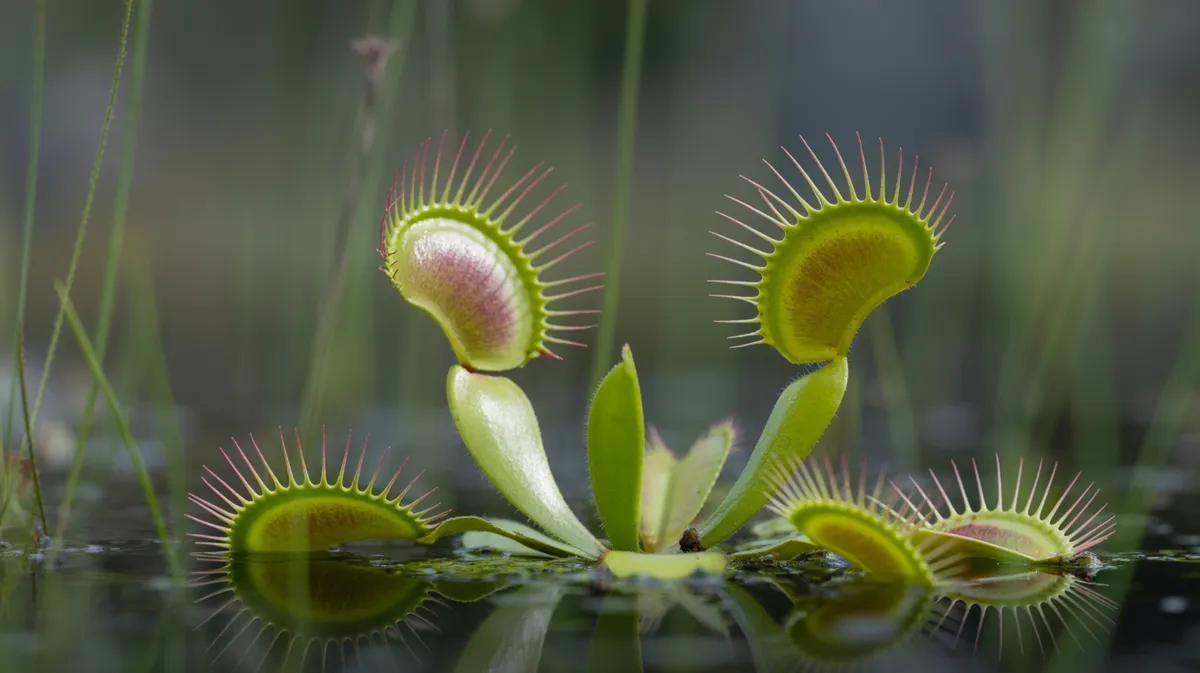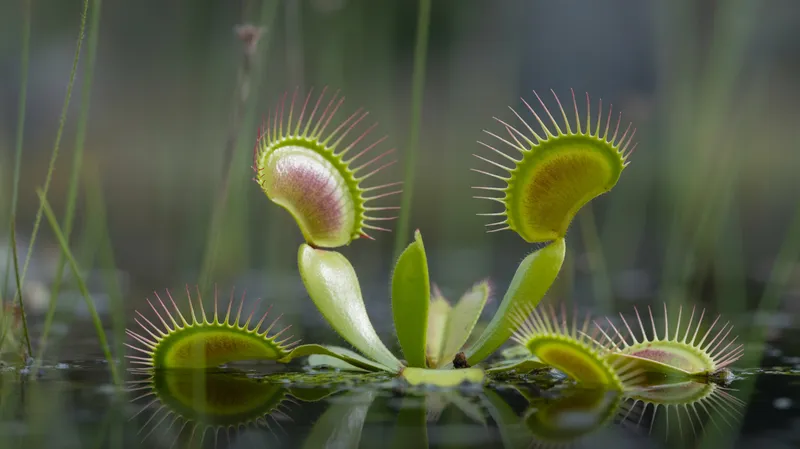
Venus Flytrap
Dionaea muscipula

Meet the Venus Flytrap
The Venus Flytrap is a small carnivorous plant native to subtropical wetlands on the East Coast of the United States, particularly in North and South Carolina. It is famous for its unique hinged leaves, which snap shut when trigger hairs are touched by unsuspecting insects or spiders. The Venus Flytrap digests its prey using specialized enzymes, extracting vital nutrients from the captured animal. Although often grown as a novelty, this rare plant faces threats from habitat destruction and poaching in the wild.
Classification
Invertebrate
Habitat
Subtropical wetlands and bogs
Diet
Carnivore
Lifespan
Up to 20 years in cultivation; 5-7 years in the wild
Conservation
Vulnerable
Weight
2-5 grams
📖Fascinating Facts
Insect Diet
Venus Flytraps primarily feed on ants, spiders, beetles, and other small arthropods that wander into their traps.
Rapid Response
The trap closes in about 0.1 seconds when its sensitive trigger hairs are touched twice within 20 seconds.
Limited Range
Wild Venus Flytraps are only found naturally within a 100-mile radius of Wilmington, North Carolina.
📋Detailed Description
The Venus Flytrap (Dionaea muscipula) is a perennial, herbaceous, carnivorous plant renowned for its rapid leaf movement and specialized prey-capture mechanism. The plant typically grows to a height of 8–15 cm, with a rosette of 4–7 leaves, each terminating in a distinctive bilobed 'trap' measuring 2–3 cm across. The inner surfaces of the lobes are lined with sensitive trigger hairs (usually three per lobe), which, when touched twice within about 20 seconds, initiate a rapid closing response. The lobes' edges are fringed with stiff, interlocking cilia that form a cage-like barrier, preventing escape of prey. After closure, glands on the inner surface secrete digestive enzymes, breaking down soft tissues of insects and arachnids over 5–12 days, after which the trap reopens to reveal indigestible remains. The plant is capable of photosynthesis but relies on carnivory to supplement nutrients, particularly nitrogen and phosphorus, in its nutrient-poor, acidic bog habitat. Venus Flytraps produce small, white, five-petaled flowers on stalks up to 30 cm tall, which help prevent pollinators from becoming prey. The species is a member of the Droseraceae family and is closely related to sundews (Drosera) and the aquatic waterwheel plant (Aldrovanda vesiculosa). Its native range is restricted to a ~100 km radius around Wilmington, North Carolina, with small, isolated populations in adjacent South Carolina. The plant is a long-lived perennial, with individual traps dying after several captures but new leaves produced throughout the growing season.
💡 Did you know?
The Venus Flytrap's trap closes in less than a second—one of the fastest movements in the plant kingdom.
🔬Research & Sources
Wikipedia Summary
The Venus flytrap is a carnivorous plant native to the temperate and subtropical wetlands of North Carolina and South Carolina, on the East Coast of the United States. Although various modern hybrids have been created in cultivation, D. muscipula is the only species of the monotypic genus Dionaea. It is closely related to the waterwheel plant and the cosmopolitan sundews (Drosera), all of which belong to the family Droseraceae. Dionaea catches its prey—chiefly insects and arachnids—with a "jaw"-like clamping structure, which is formed by the terminal portion of each of the plant's leaves; when an insect makes contact with the open leaves, vibrations from the prey's movements ultimately trigger the "jaws" to shut via tiny hairs on their inner surfaces. Additionally, when an insect or spider touches one of these hairs, the trap prepares to close, only fully enclosing the prey if a second hair is contacted within (approximately) twenty seconds of the first contact. Triggers may occur as quickly as 1⁄10 of a second from initial contact.
Last Modified: 6/1/2025
🎭Behavior & Social Structure
Venus Flytraps exhibit a unique and highly specialized hunting behavior. The plant remains stationary, relying on visual and olfactory cues to attract prey, such as nectar secreted along the trap's rim. When an insect or spider contacts the sensitive trigger hairs, the trap closes in as little as 0.1 seconds, one of the fastest movements in the plant kingdom. The double-trigger mechanism helps prevent false alarms from raindrops or debris. If the prey is small or escapes, the trap may reopen within 12–24 hours; if the prey is captured, the trap seals tightly and digestion begins. Each trap can only close and digest prey about 3–4 times before it becomes inactive and eventually dies back. The plant does not exhibit social behavior or interactions, as it is a solitary organism, but in dense populations, traps may sometimes overlap. Daily activity is largely governed by environmental conditions, with traps more responsive in warm, humid weather.
👶Reproduction & Life Cycle
Dionaea muscipula reproduces both sexually, via seeds, and asexually, through rhizome division. Flowering typically occurs from May to June. The plant produces a single inflorescence per season, with up to 10–20 small, white flowers per stalk. Flowers are hermaphroditic and pollinated by a variety of insects, including bees and beetles, which are rarely caught by the traps due to the elevated flower stalks. After pollination, the plant forms small, black, shiny seeds (1–2 mm) that are dispersed by wind and water. Germination occurs in moist, acidic substrates. Asexual reproduction occurs when the underground rhizome divides, producing genetically identical daughter plants. There is no parental care; seedlings are independent from germination.
🛡️Adaptations & Survival
The Venus Flytrap's most remarkable adaptation is its rapid, touch-sensitive trap, an evolutionary innovation for capturing animal prey in nutrient-poor soils. The double-trigger mechanism reduces energy waste by minimizing false closures. The interlocking cilia prevent prey escape, while digestive glands secrete enzymes capable of breaking down chitin and proteins. The plant's ability to photosynthesize allows it to survive periods without prey. Its roots are shallow and adapted for water absorption in saturated, acidic soils. The tall flower stalks prevent self-pollination by spatially separating reproductive organs from traps. The plant also exhibits dormancy in winter, reducing metabolic activity and conserving resources.
📚Research Sources
🎨Cultural Significance
The Venus Flytrap has fascinated people since its discovery in the 18th century, symbolizing the wonders of plant adaptation and carnivory. It has appeared in literature, film, and art as an emblem of exoticism and predation, most famously inspiring fictional plants in works like 'Little Shop of Horrors.' The plant is a popular subject in botanical gardens and as a houseplant, though wild collection is now illegal. In local folklore, it is sometimes associated with mystery and the supernatural. The Venus Flytrap is also used in educational settings to illustrate plant behavior and evolution.
🔬Recent Research & Discoveries
Recent research has focused on the biomechanics of trap closure, revealing the role of electrical signaling (action potentials) and turgor pressure changes in rapid movement. Studies have identified specific digestive enzymes and their genetic regulation. Conservation genetics research is ongoing to assess population structure and inform reintroduction efforts. There is also interest in the plant's microbiome and its role in nutrient acquisition. Ongoing habitat restoration projects aim to reestablish fire regimes and hydrological conditions necessary for survival. The Venus Flytrap continues to serve as a model organism for plant neurobiology and evolutionary ecology.
🎥Wildlife Videos

Hungry Venus flytraps snap shut on a host of unfortunate flies | Life - BBC
Glands in the lobes then secrete enzymes that break the dinner down into a digestible soup. Ten days later, the trap pops open to ...
BBC

The Venus Flytrap's Deadly Speed | Natural Born Killers | BBC Earth
One wrong step and these insects are snapped up! Subscribe: http://bit.ly/BBCEarthSub The Venus Fly Trap's Deadly Speed From ...
BBC Earth

Exploring the Venus Flytrap with Attenborough | BBC Earth
David Attenborough looks at how this well known carnivorous plant captures its prey. Watch more high quality videos on the BBC ...
BBC Earth

Death Trap (1986)
Studying carnivorous plants, which get essential nutrients by trapping and eating small organisms. Included: the Venus' flytrap, ...
ThisOldVideo2

The giant water lily is VICIOUS! 😱 The Green Planet 🌱BBC
#BBC #GreenPlanet #BBCiPlayer #documentary Watch The Green Planet on iPlayer.
BBC

What Is the Weirdest Thing a Venus Flytrap Eats?
There's no way a Venus flytrap can catch this quick little wasp. Or is there? The Venus flytrap has long been the stuff of sci-fi lore.
Crazy Creatures
🌍Habitat Information
The Venus Flytrap typically inhabits Subtropical wetlands and bogs environments. Venus Flytraps have adapted to their environments with specialized features and behaviors.
Primary Habitat:
Subtropical wetlands and bogs
More detailed habitat information will be available soon.
🛡️Conservation Status
The Venus Flytrap is currently classified as Vulnerable. Conservation efforts are crucial for preserving this species for future generations.
Common Threats:
- 🏠Habitat loss and fragmentation
- 🌡️Climate change impacts
- 🎯Hunting and poaching
- 🏭Human-wildlife conflict
⚠️Threats & Conservation Challenges
The Venus Flytrap is classified as 'Vulnerable' by the IUCN and is listed under CITES Appendix II due to ongoing threats. Major challenges include habitat destruction from urban development, agriculture, and fire suppression, which alters the open, sunny conditions required for growth. Illegal poaching for the horticultural trade has significantly reduced wild populations. Climate change poses additional risks by altering hydrology and increasing drought frequency. Invasive species and pollution further degrade its specialized habitat. Current estimates suggest fewer than 35,000 individuals remain in the wild, with populations continuing to decline.
🔬Scientific Classification
Scientific Name
Dionaea muscipula
Classification Hierarchy
🔍 About Taxonomic Classification
Taxonomic classification is a hierarchical system used by scientists to classify and organize living organisms based on shared characteristics and evolutionary relationships.
The system moves from broad categories (Kingdom) to increasingly specific ones, with each animal's scientific name typically consisting of its Genus and species.
📝Community Notes
Share your observations and insights about the Venus Flytrap with our community of wildlife enthusiasts.
Join Our Community
Sign in to share your observations and connect with fellow wildlife enthusiasts.
Sign In to ContributeNo community notes yet
Be the first to share your observations about the Venus Flytrap!
Explore Venus Flytrap
Select a tab above to learn more about this amazing animal.
📸Photo Gallery
No photos available for this animal yet.
🌟Discover More Wildlife
Continue your journey of discovery with more fascinating animals from our database
